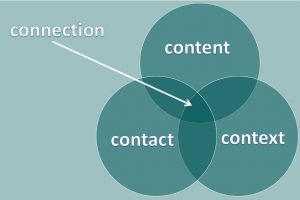 In this era of social media influencers, anyone who’s read a book or watched a TED talk can self-promote as an expert in that topic. Now that we’re isolating in a pandemic and everyone is rushing online, I could be a legit distancing diva. After all, I’ve been working, coaching and training online since the ’90s. And I know how to use breakout rooms, polls and whiteboards on Zoom and have the power to mute anyone at will.
In this era of social media influencers, anyone who’s read a book or watched a TED talk can self-promote as an expert in that topic. Now that we’re isolating in a pandemic and everyone is rushing online, I could be a legit distancing diva. After all, I’ve been working, coaching and training online since the ’90s. And I know how to use breakout rooms, polls and whiteboards on Zoom and have the power to mute anyone at will.
Unfortunately, I seem to want no part of it anymore. I’m not sure why, except that it worries me.
LEVERAGING TECHNOLOGICAL INTERMEDIATION
Buzzwords make you look smart, right? I see folks in my professional world believing, imagining or pretending that their online tools connect them. They judge that they – both people and tools – are being effective. They wonder what made us think work teams needed to be co-located. Unfortunately, no matter how good the tools are, they provide, at best, a shallow, fabricated, artificial connection. When work requires true collaboration, is real communication happening when we spend our days on Zoom?
I recognize that tools are what we have, as we isolate, temporarily, in this pandemic. And I’m rather fond of what Zoom has done and can do for me and my tribe. What worries me is my certainty that some business people, watching work groups make this ‘remote work thing’ actually work, are thinking, “Hey, this ‘remote work thing’ actually works; let’s keep it going. We’ll save on premises costs, travel and the hassles of dealing with people all day.” The cost issue, alone, will be attractive once the pandemic ends and the accountants tally the financial impact while the PR folk position this to maximize share price.
Worry Number One: What will be missing when technology is, forever, intermediating? Even deluxe, wonderful intermediary platforms (Adobe Connect, iObeya, D2L, etc.) require careful thought about what, why, with whom and in what context we are communicating. Are we considering these things when we set up – or sit through – the seventh online meeting of the day? Or when we reformat our highly interactive in-person workshops as webinars? Or when we move our annual conference to virtual? Or when we forget that there are still neighbourhoods without reliable highspeed?
Worry Number Two: Are we chasing solutions before we understand the problem? And what is the problem, anyway?
 4-Cs Model: Yeah, yeah. I know about the George Box quote, “All models are wrong, but some are useful.” I developed this model, years ago, when I was trying to get bosses, colleagues, clients in the business world to recognize that communication only happens when we make a connection. And connection only happens when our message, or content, is aligned with the situation people are in, or context, and the channel or means of contact.
4-Cs Model: Yeah, yeah. I know about the George Box quote, “All models are wrong, but some are useful.” I developed this model, years ago, when I was trying to get bosses, colleagues, clients in the business world to recognize that communication only happens when we make a connection. And connection only happens when our message, or content, is aligned with the situation people are in, or context, and the channel or means of contact.
We can make working from home work if we’re thoughtful about the content, context and means of contact, matching tools to tasks. We can make it work if we remember that we are dealing with people, unpredictable, creative, quirky and oh so human. As I and others have said before, this is a weird time. Working at home is our response to ‘sheltering in place during a pandemic’ or ‘staying safe in a crisis.’ Let’s hope it’s temporary and not ‘a new way of working.’
